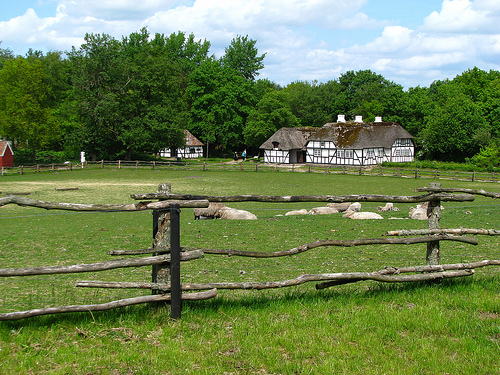

Location: Hjerl Hedevej 14
Tel. 97 44 80 60
Open: Apr & Oct:
11am- 4pm days vary
May- Sep: 10am- 5pm daily
Late June- mid- Aug:
10am- 6pm daily
Late Nov- mid- Dec: 10am- 5pm Sat & Sun
The open-air museum Hjerl Hede is an open-air
museum at Vinderup between Skive, Struer and Holstebro in West
Jutland. The open-air museum contains several preserved and
reconstructed buildings, historic gardens with flowers, fruit trees
and useful plants, old Danish livestock breeds, as well as
agricultural crafts and examples of the utilization of arable land,
heath, forest and bog, which shed light on rural life in Denmark in
the years between 1500-1900.
Frilandsmuseet Hjerl Hede should
not be perceived as a coherent village, but as a collection of
"homes" from the country separated in time and space. Since 2017,
the museum has been working to find stories about the people who
actually lived in the houses, and tried to furnish the houses so
that they look exactly like their homes.
In 2012, the outdoor
museum, together with Holstebro Museum and Strandingsmuseum St.
George united in one organization under the name De Kulturhistoriske
Museer i Holstebro Municipality.
The museum's areas of
responsibility cover a wide range and include, among other things,
ongoing collection, registration, conservation, research and
dissemination within the museum's areas of responsibility.
It all began in 1910, when the businessman Hans Peter
Hjerl Hansen (1870-1946) bought "Vadsøgaard" with two large heath
parcels from Jattrup and Hjelm Heder by Flyndersø and called the place
Hjerl Hede. His intention was to plant the heath, but he had to accept
criticism, not least from the poet Jeppe Aakjær, who wanted to preserve
the Jutland heath. He himself was also determined that parts of the
heath should be kept free from planting, and in 1934 Hjerl Hede was
protected.
H. P. However, Hjerl Hansen was also historically
interested. This led him in 1928 to buy "Denmark's oldest farm"
Vinkelgården from the village of Vinkel east of Viborg, which was taken
down during 1929 and moved to Hjerl Hede. It happened to the National
Museum's great regret, but the museum was unable to raise the money
within the set deadline. This laid the foundation for what is today the
Hjerl Hede Open Air Museum.
H. P. Hjerl Hansen invited the
residents of the area to come and see the rebuilt Vinkelgård before it
became available to the public, and on 27 July 1930, 500-600 people
found their way to the place where H.P. Hjerl Hansen, Mogens Clemmensen
and H.P. Hansen spoke for the assembled. The date is considered for
posterity as the start of H.P. Hjerl Hansen's unique building
collection. Much suggests that H.P. When Hjerl Hansen bought
Vinkelgården, he had plans for an open-air museum on Hjerl Hede. Already
in 1930, the stump mill from Frøslev was acquired, and in 1931, the
smithy from Vester-Kærby and the mill from Hejsager followed. An
open-air museum thus took clear shape from 1930. In 1931, H.P. Hjerl
Hansen Hjerl Hede with all buildings for the Hjerl Foundation, with
which the preservation of the collection was ensured.
On 24 July
1932, the first revitalization was held at Hjerl Hede, which at the time
housed four of the nearly 50 buildings that the museum has today. This
summer day, people were invited to "a day in the village 100 years ago",
where local people dressed in old-fashioned clothes showed old rural
working methods in handicrafts, housework and other daily chores. They
had expected 5,000 visitors, but twice that number came. The day was
documented with film, which became the documentary Indvielse af Hjerl
Hede.
Frilandsmuseet Hjerl Hede was run as a private museum by
the Hjerl-Fonden until 1979, when it became a state-recognised,
independent cultural history special museum. On 1 January 2012,
Frilandsmuseet Hjerl Hede merged with Holstebro Museum and
Strandingsmuseum St. George, and the museum merger was named De
Kulturhistoriske Museer i Holstebro Municipality, which has the status
of a state-recognised museum. The three museums will continue their
activities and tasks at their current addresses.
In 2006, a 1,875
square meter visitor center was built, which includes ticketing, a shop,
teaching rooms, exhibition rooms and office facilities.
The collection consists of buildings that illustrate
home furnishings and building practices in the countryside in Denmark.
The oldest house in the museum is Vinkelgården, which in 2014 was
dendrochronologically dated to the winter of 1545/46, and which may thus
be the oldest preserved farmhouse in Denmark. Among the many buildings
there is a bullade from Hejsager near Haderslev (from ca. 1777), a stub
mill from Frøslev on Zealand (1778), a water mill from Vesterby near
Vejle, a homestead from Kvosted near Viborg (1815), a school building
from Hinge near Silkeborg (1823), an arable barn from Als (1632), a
four-legged sole farm from West Jutland, a barn from Sorring by
Silkeborg (approx. 1840), a dairy from Mandø (1897), a spray house from
Tybjerg on Zealand (approx. 1860) , a gunner's house from Gjerrild, the
village inn from Skovsgårde on Northwest Funen (ca. 1750), the
parsonage's farmhouse from No. Aarslev near Randers (17th century/1854),
as well as a reconstruction of a Romanesque church from the early Middle
Ages with Tjørring Church as a model and frescoes with models in Råsted
Church.
The museum's collection covers the period up to the
beginning of the 20th century. The museum is known for using animation
in communication, i.e. that in the workshops and in the houses there are
people who work with traditional crafts and use old working methods. The
open-air museum Hjerl Hede works purposefully with the preservation of
old Danish agricultural crafts and old Danish livestock breeds. Since
1955, the museum has dominated a reconstructed Stone Age settlement.